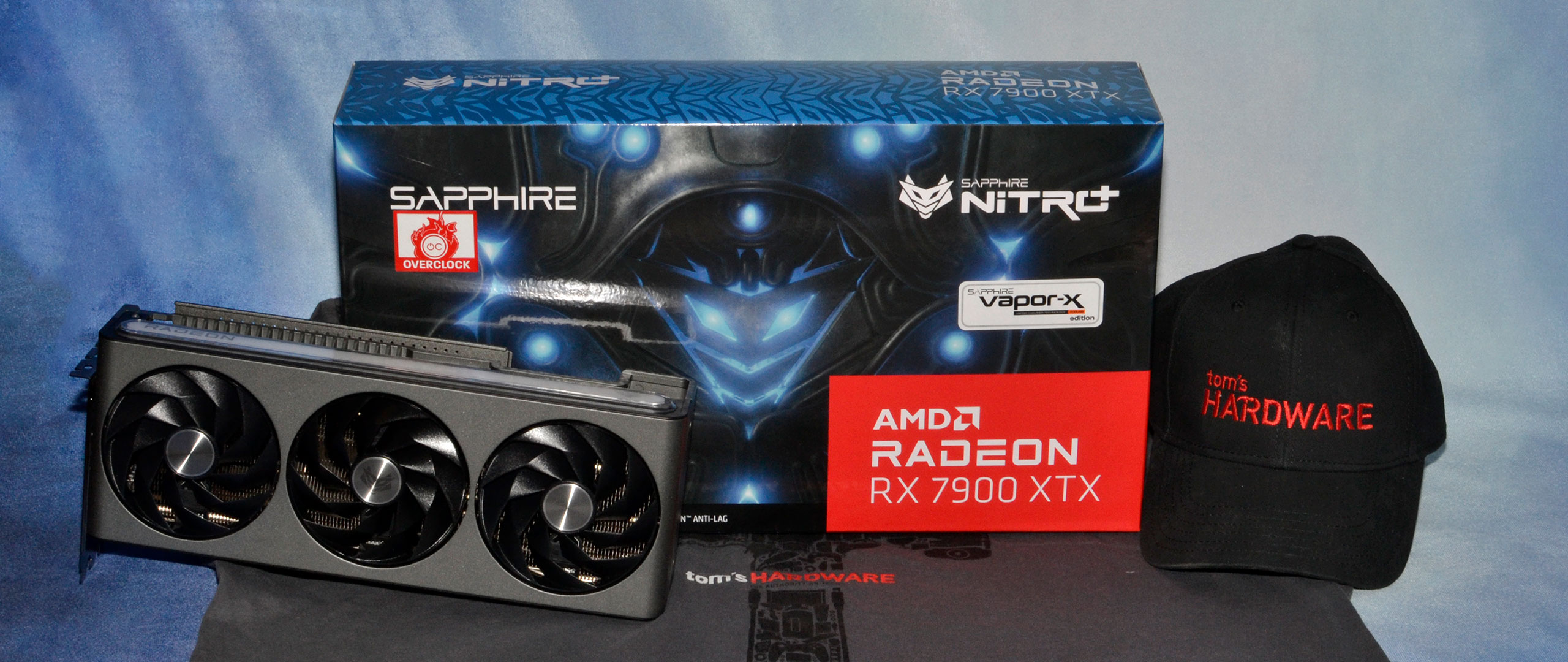
Sapphire RX 7900 XTX Nitro+ Vapor-X Review: More Is More
Tom’s Hardware Verdict
The Sapphire RX 7900 XTX delivers the usual factory overclock with a large cooler to cope with the higher clocks and significantly higher power consumption. You can run at lower settings, but then why bother with an extreme model in the first place?
Pros
- +
Great cooling and performance
- +
Lots of RGB lighting (if you like that)
- +
Good build quality
Cons
- –
High power use for minimal performance gains
- –
Costs more than other 7900 XTX cards
- –
Relatively limited availability at present
- –
Too much RGB for some people
Why you can trust Tom’s Hardware Our expert reviewers spend hours testing and comparing products and services so you can choose the best for you. Find out more about how we test.
The Radeon RX 7900 XTX and XT launch wasn’t quite enough to claim the pole position in our GPU benchmarks hierarchy, and now we’ve learned a few batches of reference 7900 XTX cards shipped with vapor chamber issues. The Sapphire RX 7900 XTX Nitro+ Vapor-X has no such problems, promising the usual bump in performance thanks to higher clocks and a better cooler — and slightly higher power draw as well. How does it fare when compared with the best graphics cards, and can you find cards in stock anywhere?
As with other third-party AIB (add-in board) partner cards, the only real changes relative to the reference designs will come in the form of cooling and aesthetics, potentially with a bump in clock speeds and power limits. Sapphire’s RX 7900 XTX Nitro+ follows that pattern to a T:
| Graphics Card | Sapphire 7900 XTX Nitro+ | RX 7900 XTX | RX 7900 XT | RTX 4090 | RTX 4080 | RTX 4070 Ti |
|---|---|---|---|---|---|---|
| Architecture | Navi 31 | Navi 31 | Navi 31 | AD102 | AD103 | AD104 |
| Process Technology | TSMC N5 + N6 | TSMC N5 + N6 | TSMC N5 + N6 | TSMC 4N | TSMC 4N | TSMC 4N |
| Transistors (Billion) | 45.6 + 6x 2.05 | 45.6 + 6x 2.05 | 45.6 + 5x 2.05 | 76.3 | 45.9 | 35.8 |
| Die size (mm^2) | 300 + 222 | 300 + 222 | 300 + 185 | 608.4 | 378.6 | 294.5 |
| SMs | 96 | 96 | 84 | 128 | 76 | 60 |
| GPU Shaders | 12288 | 12288 | 10752 | 16384 | 9728 | 7680 |
| Tensor Cores | N/A | N/A | N/A | 512 | 304 | 240 |
| Ray Tracing “Cores” | 96 | 96 | 84 | 128 | 76 | 60 |
| Boost Clock (MHz) | 2680 | 2500 | 2400 | 2520 | 2505 | 2610 |
| VRAM Speed (Gbps) | 20 | 20 | 20 | 21 | 22.4 | 21 |
| VRAM (GB) | 24 | 24 | 20 | 24 | 16 | 12 |
| VRAM Bus Width | 384 | 384 | 320 | 384 | 256 | 192 |
| L2 Cache | 96 | 96 | 80 | 72 | 64 | 48 |
| ROPs | 192 | 192 | 192 | 176 | 112 | 80 |
| TMUs | 384 | 384 | 336 | 512 | 304 | 240 |
| TFLOPS FP32 | 65.9 | 61.4 | 51.6 | 82.6 | 48.7 | 40.1 |
| TFLOPS FP16 (FP8/INT8) | 132 (132) | 123 (123) | 103 (103) | 661 (1321) | 390 (780) | 321 (641) |
| Bandwidth (GBps) | 960 | 960 | 800 | 1008 | 717 | 504 |
| TBP (watts) | 420 | 355 | 300 | 450 | 320 | 285 |
| Launch Date | Dec 2022 | Dec 2022 | Dec 2022 | Oct 2022 | Nov 2022 | Jan 2023 |
| Launch Price | $1,099 | $999 | $899 | $1,599 | $1,199 | $799 |
Sapphire prices its Vapor-X model $100 above the reference card, with a $1,099 price point. MSRPs mean next to nothing, unfortunately, and Newegg has a listing for $1,522.97 (opens in new tab) — plus $49.99 in shipping, to add insult to injury. (It’s from a third party seller, naturally.) Not that the reference 7900 XTX is any better, currently listed for $1,439.99 from a different third party seller (opens in new tab).
Hopefully the supply and pricing will improve in the coming months, but right now the 7900 XTX cards are all quite overpriced. The 7900 XTX typically beats the RTX 4080 in rasterization performance while trailing by a significant amount in complex ray tracing games, but RTX 4080 cards start at $1,269.99 (opens in new tab). That’s more than we’d like but also about $200 less than the 7900 XTX for the time being.
If you want to learn more about AMD’s RDNA 3 architecture, that article’s a good place to start. Sapphire’s design doesn’t radically change anything, so we mostly know what to expect, but let’s go ahead and check out the card itself and take it apart.
- MORE: Best Graphics Cards
- MORE: GPU Benchmarks and Hierarchy
- MORE: All Graphics Content


